Nakul Mandan, Partner at Lightspeed Venture Partners, sits down with three CEOs who understand the joy and pain of fundraising from investors. In this talk, David Blonski, Co-founder & COO of Elementum, Oleg Rogynskyy, CEO of People.ai, and Rajeev Behera, Co-founder & CEO of Reflektive talk about their approaches to raising a big Series A round.
What do you need to consider when comparing a strategic investor to a traditional VC? What are some of the biggest mistakes they made when they were fundraising? What’s the benefit of going from the consumer world into the SaaS world?
No matter how hard you focus on courting investors and building relationships with them, you should always keep in mind: never put investors before your customers or product.
And if you haven’t heard: SaaStr Annual will be back in 2018, bigger and better than ever! Join 10,000 fellow founders, investors and execs for 3 days of unparalleled networking and epic learnings from SaaS legends like Jyoti Bansal, Aaron Levie, Josh James, and Dustin Moskovitz. If you don’t have tickets, lock in Early Bird pricing today and bring your team from just $549! (Prices go up July 1st.) Get tickets here.
TRANSCRIPT
Announcer: Please welcome partner at Lightspeed Venture Partners, Nakul Mandan.
Nakul Mandan: Raise your hand if you’re interested in fundraising for your startup in the next 12 months.
Who here thinks, raise your hand again, that you could be better at your fundraising game?
We have a great panel for you for that exact reason. The topic here is “How to Raise a Big Ass Round.” I didn’t censor this. Jason had to censor it, I guess. We have Rajeev Behera from Reflektive. You want to come up?
Rajeev Behera: Yeah.
Nakul: David Blonski from Elementum.
Nakul: Oleg Rogynskyy from People.ai.
Nakul: All three of these founders have raised large rounds relative to their scale whenever they did raise those rounds. I think it’ll be good to get their stories out. Why don’t you guys start with, maybe, a 30 second intro on each of yourselves, and then we can dive right in.
Oleg Rogynskyy: Sure. Hi, I’m Oleg Rogynskyy, CEO and Founder of People.ai. We’re building an AI to help companies manage their sales teams. All the sales managers make the decisions based on intuition and their gut feel about their teams in terms of coaching, in terms of ramping reps, in terms of knowing what they do.
We are making sure that’s done based on data going forward. We started, what, 11 months ago? Since then, we’ve raised a large round, we’ve grown, we’ve acquired 50 paying enterprise customers and growing really fast.
Nakul: David?
David Blonski: My name’s David Blonski, I’m the co founder and COO of Elementum. We provide real time visibility solutions for supply chain management, and this goes to the biggest companies in the world. If you think about it, if you buy something for $5 from Amazon, you know every step of the way where it is.
These companies that spend billions and billions of dollars have no idea where their products are at any given time, or if there’s any problem. What we do, we give real time information and some recommendations along the way to hopefully save them a lot of money.
Nakul: Rajeev?
Rajeev Behera: Hi, I’m Rajeev Behera, the founding CEO of Reflektive. We’ve raised $42 million so far. What we do, we’re a SaaS platform, and some of you’ve probably done performance reviews at a company before, and most of you probably really disliked the process.
Our goal is to kill performance reviews and move companies to a system of more real time feedback and development so that instead of just spending once a year evaluating employees, the process is meant to help develop and engage employees.
Nakul: Great. Maybe starting with you, Oleg. You went through the YC Program last year. YC has become the Stanford for the startup ecosystem. What was the one important fundraising lesson that you got out of that program that you then leveraged in your fundraising process?
Oleg: YC actually told us not to talk to VCs at all. Instead, they told us to focus on building the product and talking to customers and build something people want. That’s what we did.
We focused on the product. We spoke to hundreds of customers. We built the product, went to market, and then in 30 days, we had a hundred loggers using the product. That’s where YC strategy is.
Nakul: David, your first round was interesting. You raised a pretty big series A, which was a $17 million series A, but you also raised it from a strategic. Can you talk about what are the pros and cons of raising from a strategic investor versus a traditional VC?
David: For us, being in the supply chain space, the biggest thing that we had was credibility. We needed credibility. Me and my co-founder, we were a couple 20 something year olds and trying to tell companies how to run their global supply chains. We needed a proof point. We needed somebody who said, “Yes, we believe in them. This is how we did it.” We also wanted to test it with them.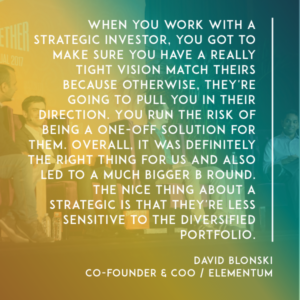
The flip side is that when you work with a strategic, you got to make sure you have a really tight vision match, because if they’re off and to the side of what you want to do, they’re going to pull you. You run the risk of being a one-off solution for them.
The flip side, though, is if you are well aligned, they have no concept of what a series A means, of patience, of what it takes to actually develop product. They’re going to push you and push you. They’re going to have their own internal competitors. They’re going to look at external competitors. It is a bit of a Catch 22. It hit our biggest need of credibility.
It’s had its challenges, but it overall was definitely the right thing for us and it also led to a much bigger B round. Because the nice thing about a strategic is that they’re less sensitive to the diversified portfolio. They have money. They put money in.
[crosstalk]
Nakul: …ownership.
David: They were able to support us, and also put some price pressure up there to make it competitive for the next VCs that eventually came in the B.
Nakul: I’m curious, were you talking to VCs as well as Flextronics in this case at the same time?
David: Yes, and they said, “No freaking way.” They said, “The vision’s too big. It’s crazy. It’s an old space. You can’t do it.”
What we did is we found a strategic who actually desperately needed it. Our strategic is a company called Flex. They do contract manufacturing. Supply chain is critical for them, but they have no concept of software development. It was really a very good partnership, where they needed it, they needed us, and it led to what’s been a very productive relationship.
Nakul: Rajeev, yours is an interesting story. You came from the consumer world, all your career before Reflektive was in the consumer, and, gaming, and product marketing world. How did you convince somebody to give you money and a pretty large seed round on a SaaS product?
Rajeev: I think actually coming from consumer helped me raise my round. I could tell when I was speaking with investors. That was one of the key differentiators with me. When you think about people attacking a space and you’re trying to disrupt it coming up with something innovative.
If you approach it from a different angle and you just think differently than everyone else you’re competing with, it gives you a nice edge. Where I came from, the thing I did right before I started Reflective was I put out a Marvel Avengers game at Disney, which I was running product for. It’s consumer driven. It was a free to play game.
When you build those games, you start understanding how users work and how not intuitive it is in terms of what they understand when they get into the app, what they want to do. You learn a lot from that. We learned that mostly when people are on apps, they’re using 20 percent of their brain. 80 percent of their brain’s thinking about other things, so they’re completely distracted.
You learn patterns of usage for all apps throughout the day for certain types of people. You just learn a lot of things that give you different angles to approach different problems. We’re tackling the HR space, and no one in my space is from consumer. When I talked about how I thought about it, I think that by itself was one of the strengths actually.
Nakul: Did you also feel that because you raised a large round post launch of the product showing that the engagement data was showing the kind of consumer engagement atypical of B2B companies was equally critical because you were leveraging your background and actually showing that in results when you were raising your seed round? Is that right?
Rajeev: Totally. The typical B2B founder would pitch a certain set of SaaS metrics when they pitched their seed round or their A round. For me, the metrics we measured were the same metrics we measured when we were building games at Disney and played them. Retention curves, usage curves, internal virility and re-engagement metrics.
Those were the things we cared about because our premise was, “No one uses HR software, and no one wants to use it. Let’s build something that people actually want to use.” To measure that, we measured it the same way we’d measure a free to play game.
When we pitched a lot of our slides, now looking back on it, my slide decks now look very different [laughs] from my slide decks when I had the consumer mentality where I had a bunch of slides on usage and engagement by different companies and just how viral growth happened with our product. We showed that people adopted Reflektive on their own volition within companies.
We saw penetration within companies. A lot of consumer driven metrics was a big part of my slide deck. In early stage or early revenue anyways, I thought it must have been refreshing for people to see actual usage data when there’s very little sales data anyways to pitch.
Nakul: Generally, I found that fundraising is a tough exercise. Different founders take a different tack to it. There are different ways to win at that game. Everybody has a secret sauce to how they pitch successfully. I’d be curious for each of you to answer actually, maybe starting with you, Oleg. What’s your secret sauce in fundraising?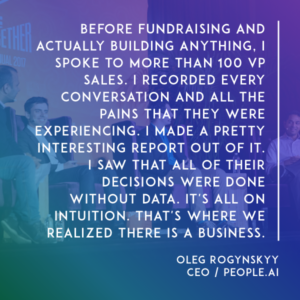
Oleg: My secret sauce was showing the actual path to how I get to product market fit. Before fundraising and before actually building anything, I went out to the market and spoke to 100 VP sales, more than 100. I recorded every conversation. I made a pretty interesting report out of it. I recorded all the pains that they were experiencing.
While doing that, I realized that there’s only five things sales managers do, which is hiring reps, ramping them, analyzing what they do, understanding that, coaching them, and then promoting or letting them go. Once I realized that, I also saw that all of these decisions are done without data. It’s all on intuition. It’s all on hunch. That’s where we realized there is a business.
We built the product that addresses those pain points. The moral of the story is that if you show the investors how you will get to product market fit and you show how you over laid that onto your road map, they’ll believe you. You likely will get funded.
Nakul: Mapping the research, like primary research you did with the feature set and saying, “This is the pain. This is the feature. This is the pain. This is the feature…”
[crosstalk]
Oleg: Here’s proof. Here’s how I’ve done the homework, and you can go and check it. You can use my homework to figure it out as well. Educating investors who may or may not have looked into your market and putting them on the same page as you is probably a sure thing.
Nakul: David?
David: I think, for us, it’s two sides. One is that there’s $25 trillion of product that gets produced every year. At any given time, there’s $12 trillion just sitting anywhere. There’s nobody in the world who addresses that. No one.
You say that, and very clearly people are either going to get it or they don’t. If they get it, then the key is having happy customers.
For us, it started with our first strategic investor. Getting them to be happy and be a showcase, and then leverage them into other happy customers. If you could show that that market is huge, it’s untapped, and you have some really happy customers, then the two just make sense. Now you can have a good productive conversation of what’s the right fit to move forward.
Nakul: Rajeev?
Rajeev: I think of it as three buckets, you’re selling vision, metrics, and customer stories. Your vision has to be very different and unique. There’s a ton of companies out there. A lot of them are slight iterations of others, but why does your company deserve to exist? That’s one question I would ask myself when I thought about my pitch.
Should it exist or should it not exist? Is it big enough or different enough for it to exist? Pitch that vision. If it doesn’t feel big enough, then think about it again.
Second is metrics. You just get all your metrics in place. Know that you know all of your stuff. You know what the sales funnel looks like, everything that has to do with your product, and then back it up with customer stories.
The metrics help ground investors to understand what the business looks like. To get the feeling around what the actual product does, the impact it has on people, impact it has on businesses, it’s helpful to have good customer references, which means from the get go, it’s super important to spend a lot of time with your customers.
Even if you’re the founder or the CEO, you’re really busy, maybe you’re the product guy, spend time on site with your customers and get them to know you really, really well, so then they’ll talk to your first set of investors.
Nakul: It’s interesting. The common thread there was customers because you said customer research at the stage where you were raising. You said, “Happy customer,” and you said, “Customer references.” That comes through. I’m curious if you guys also felt that part of your secret sauce was justifying, “Why only me can solve this problem?”
Did you guys feel that that played a role in your story?
Oleg: The thread of founder background plays an important role here as well as what the market is we’re going as well as what is the product you’re trying to build. All those three things have to be aligned into a coherent story to answer the why me, why now, why this, for it to work.
David: I actually found that in the early stages that was less important because you just figure out if you can handle it. Don’t worry about anybody else yet. Can you actually solve this problem? Is it valuable?
As we progress and we get later stage and we have more success, there’s a lot more interest to say, “Well, now what are your competitive barriers? Why are you differentiated? Is there a network effect?” All those things. Now competition is more relevant than in the beginning.
Nakul: Got it. Rajeev?
Rajeev: I think definitely in the early stages who you are is important to fundraising and why you’re different. For me, it was the consumer angle and attacking a market from a different perspective. I think that was critical for me. It’s shown through throughout the few years of Reflektive, and then making sure you know your stuff.
For me, I was from consumer, so that’s a pro that I see things differently. The con of that is I don’t know SaaS metrics. I don’t know how to run B2B sales and marketing. Getting up to speed on that was crucial for me, too.
Nakul: The flip side of this trends, which we’ve been talking about, is the mistakes. Maybe starting with you, Rajeev, is there one fundraising mistake that now that you’ve raised a couple of rounds warn founders against?
Rajeev: Definitely. You want to sit down and think and talk to other founders about their investors so you can understand what you want in a partner. It’s a marriage. You can’t get divorced out of this marriage though. You want to pick someone that you really, really like working with.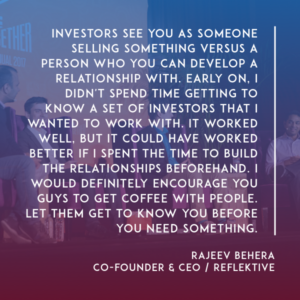
It’s hard during the fundraising mode because investors see you as someone selling something versus a person who you can develop a relationship with. Early on, I didn’t spend time getting to know a set of investors that I’d want to work with. I just went fundraising.
It worked well, but it could have worked better if I spent the time to build the relationships beforehand so I got to know people outside of the actual process. I would definitely encourage you guys to spend time beforehand. Get coffee with people. Get to know them. Let them get to know you before you need something. As soon as you need something, the relationship switches.
Nakul: Just to double click on that because often the problem with meeting for coffee is that you can also end up wasting a lot of time. Just double click on that. How do you make sure that coffee meeting results into an actual relationship being built with a person who can make the decision or help the decision?
Rajeev: Totally. It should be a two way interview. It’s going to take multiple coffee meetings to get to know somebody. In the first one, if your instincts flare up and you don’t think that’s the right person, don’t meet them again. You’re going to have to meet everybody anyways when you are fundraising.
You might as well meet them during the coffee time period beforehand, and then just cut out the people you don’t want to have secondary meetings with.
Nakul: David?
David: I made so many mistakes. It’s like over and over again.
[laughter]
David: That’s part of just building a company. Any company, you make a lot of mistakes. Fundraising is no different. I think, Rajeev, you brought this up earlier with us, is valuation. Don’t focus so much on valuation, especially at the Series A because what you don’t realize is that that’s just going to create pressure for you.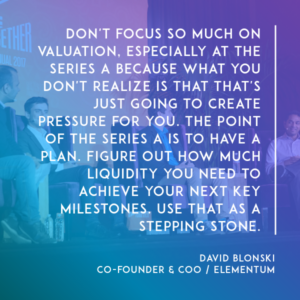
The point of the Series A is have a plan. Figure out how much liquidity you need to achieve your next key milestones. Use that as a stepping stone. It’s not meant to set… Nobody’s getting rich off of a Series A. In fact, the higher the valuation, the more difficult it makes to recruit people because they’re going to say, “Wait. Why is this so high already?”
It’s going to put pressure on your next round to say, “Well, you better go ahead and hit these next several steps.” Just right off the bat, I think being somebody who hadn’t fundraised before, it was, “Oh, we need a high valuation because we want to minimize dilution.” Well, that’s going to work out over the course of the company’s lifetime.
A good VC is not going to let you over dilute yourselves, but the valuation can put pressure on you. I’d stress that. Be more focused on what do you need as a business, who’s the right partner for you, and what are those milestones that you actually need to achieve? The valuation will work itself out as you progress and mature.
Nakul: Oleg?
Oleg: I’m seeing a lot of founders actually come off too desperate or too available. At YC, they were teaching us, “Hey, build your product. Talk to your customers. That’s the main focus. If you keep on doing that and if you keep on getting traction, then investors will come.”
On the other hand, if you’re too available and an investor emails you today and then you’re ready to meet today or tomorrow, that means you definitely have nothing else to do. That’s actually a negative signal for investors. We were meeting with investors two, three, four weeks out, and always focused on product and customer. From there, we would…
[crosstalk]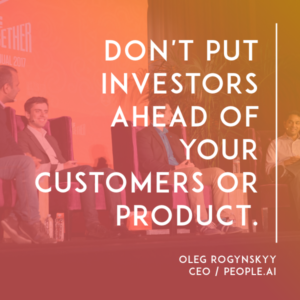
Nakul: The point both of you are making though it’s not three weeks during the fundraising process. You’re saying, “Get to know your investors potentially earlier,” and you’re saying, “Don’t be always overeager to meet the guy next day. Focus on the business but also still meet them three weeks later or whenever the timing is right.”
Oleg: Yeah, don’t put investors ahead of your customers or your product.
Nakul: That’s a great point.
I guess, just double clicking on a little bit of the process itself, maybe, Rajeev, you could answer this. Because fundraising processes can drag on for very long, how should founders think of creating some urgency in the process to draw it towards a close and yet let investors complete their diligence?
Because you could piss them off and say, “Hey, there’s no time to complete our diligence. I’m backing off.” At the other end, you could also have a three month diligence process that’s not leading too much, especially at Series A and B. Do you have some thoughts on that?
Rajeev: I think one of the arts around fundraising is sequencing the fundraise with the multiple investors you’re talking to. You never want to get too far ahead with one investor. Ideally, you want to create deal heat.
You want multiple investors at the same time and have them bid up your price. You may not want to take the higher price, but you want the option, and you want people to move.
If you think about the way investors think, they want as much data as they can get before they have to make a decision. They’re going to wait as long as they can to make a decision. Because of that, they won’t make a decision unless they have to which means they only have to when someone else is going to take the deal off the table.
You think about the rules of engagement there, and you use that to push everybody in lockstep together. If you let one person go ahead of the others, then if that person’s ready to give you a term sheet, then you will not have any deal heat because no one else is ready.
Basically, you have to explicitly stop people and slow the process down. You get people, say, “All right, let’s get ready. Now stop,” and then go to the next step and then stop. I think that’s worked well for me where you sequence everybody together, gives everyone enough time.
For this to happen, you have to start fundraising before you run out of money. Make sure you start it six, nine months in advance before any of those dates can happen so you can take your time.
Nakul: David, some founders out here probably have long sales cycles, are building things in the industry loyalty space or more old school industries. You have both those dynamics in your business.
Investors typically stay away from long sale cycles or old school industries as customers. How did you counter that in your own relative round of fundraising specifically?
David: To start with, VCs tend to specialize in different areas. Some VCs are known for consumers. Some VCs are known for social crowdsourcing. Some VCs are known for enterprise.
Just begin with, recognize who you are and who your likely partners are. For us, Lightspeed is well known in the enterprise space. That was already a natural fit where they understand some of those dynamics.
Nakul: Even within enterprise, you’re saying enterprise versus people who are more focused on freemium or mid market or something like that.
David: Right. Look for somebody who has a good fit. It’s going to come back again somewhat to metrics that a long sale cycle for us…
When we first started, it would take nine months to sell a $50,000 deal or it would take nine months to sell a $10 million deal. Let’s figure out what makes sense. When we do the $10 million, my customer acquisition cost, my lifetime value becomes compelling.
Oracle, NetSuite, Workday, they’ve all done fine with long sale cycles. The key is making sure that the value justifies those sales cycles.
Nakul: I guess what you are saying in short is picking the right investors to even talk to.
David: Right. Some people aren’t going to get it to begin with. It’s just not the right fit. Figure out who’s in your space and then make sure your business still has to perform and justify through the numbers.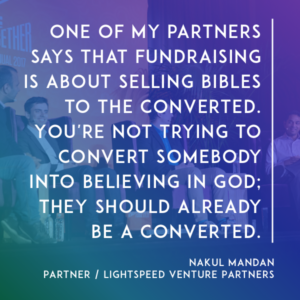
Nakul: One of my partners says that fundraising is about selling Bibles to the converted. You’re not trying to convert somebody into believing in God during those three weeks. They should already be a converted…
David: Completely agree. They’ll get it. You’ll see right away either they get it or they don’t. Don’t waste time on the ones who don’t and don’t take it personally. They’re just not in your space.
Probably with a little bit of homework, you can also figure out if you fundraised before, your existing investors can probably recommend and say, “We’ve partnered well with these people. They get it. They’re in that space. They understand the challenges.”
Something about fundraising is that A, B, C, no business is perfect. It’s completely flawed. We all have plenty of challenges, whether it be technical, team oriented, whatever it is. Find people who understand what the biggest challenges are and accept that, and then work through it.
Nakul: Just leading on that, Oleg, how should one target investors then? Your case was specific around old school industries, longer sales cycle, but a lot of things are more horizontal software.
Both in your cases, starting at mid market, horizontal software solutions, how do you still target the 5 to 10 people you have to talk to?
Oleg: We were optimizing on finding the right partner at the firm. There’re plenty of brand names out there.
Nakul: So not partner, not firm?
Oleg: Not the firm but the right person. We’re looking for someone who can spend time with us, mentor me and my management team, help us with the blind spots we may have, be it growth strategy, be it pricing, and help us with vetting candidates. Someone who will be hands on, and I’m glad we found someone.
Nakul: There are probably a lot of founders here who are here today but they’ve come from outside the Valley. Obviously, raising in the Valley is a different game altogether. The network density of VCs is here.
If you guys were to give one advice on fundraising for people who are coming from outside the Valley to raise in the Valley, what would be that advice?
Oleg: It’s very simple. Move to the Valley.
[laughter]
Oleg: Establish yourself here and customers, investors, candidates will come and find you. If you can’t move to the Valley, establish a permanent presence here. Open an office. Hire some people. Be here quarter of your time, half your time, as much as you can. That’s going to be a pretty good boost for a business.
Nakul: David?
David: I don’t know. I haven’t worked outside the Valley. We’re fortunate to be here.
What I can say is that what I think the biggest strength of the value outside of the investment base is the talent. If you’re going to come and pitch to VCs here, you better be prepared to explain how you’re going to recruit the best people, the best engineers, the best designers, the best technical people in general to come to work for you even though you don’t live here.
Be prepared to have that, an answer ready to address it.
Nakul: Rajeev?
Rajeev: The Valley has so many awesome traits that you can’t get anywhere else. It’s great just to start your business here because every other startup’s a test bed.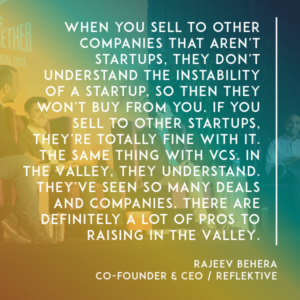
When you sell to other companies that aren’t start ups, they don’t understand the instability of a startup, so then they won’t buy from a startup. You sell to other startups, and they’re totally fine with instability of your startup as well.
The same thing with VCs, here they understand. They’ve seen so many deals. They’ve seen so many companies. They totally get the pros and cons and the hardships of building a company. There’s definitely a lot of pros to raising.
Being here is key. You have to be here to be able to do it.
Nakul: If somebody’s building their company, let’s say, in Austin or Europe and it’s still seed stage company, when they come here for the…How do you think they should engage? Any suggestions for people on how to make that engagement? Maybe after the fundraise, they’ll move here.
I agree wholeheartedly with that sentiment though, but how should they tactically approach the fundraise while they’re not based here?
Oleg: My first company was based out of Montreal. I was building there. I wasn’t moving as fast as I could move. The talent wasn’t there. You have to grow your talent. You can’t just go out to the market and get someone who has done it before four times in a row. That slows you down.
When you visit the Valley and you don’t live here, you don’t get the same access to investors, to the network, since you’re just a visitor.
If your pre Series A or seed, come out here and spend three to six months here. Bring the part of your team here. Work out of coffee shops. Meet people. Go to meetups, whatever it is. You can…
Nakul: What do you recommend coming to the YC program on the accelerated program as a kickstarter for that move?
Oleg: I movedhere before YC, but I saw a whole bunch of founders use YC as a platform to establish a beach head in the Valley for their business.
Nakul: Great. I think we are running out of time here. Thank you guys. This was a great panel and hopefully it was useful for everyone.
Rajeev: Thank you.
Oleg: Thanks for having…

